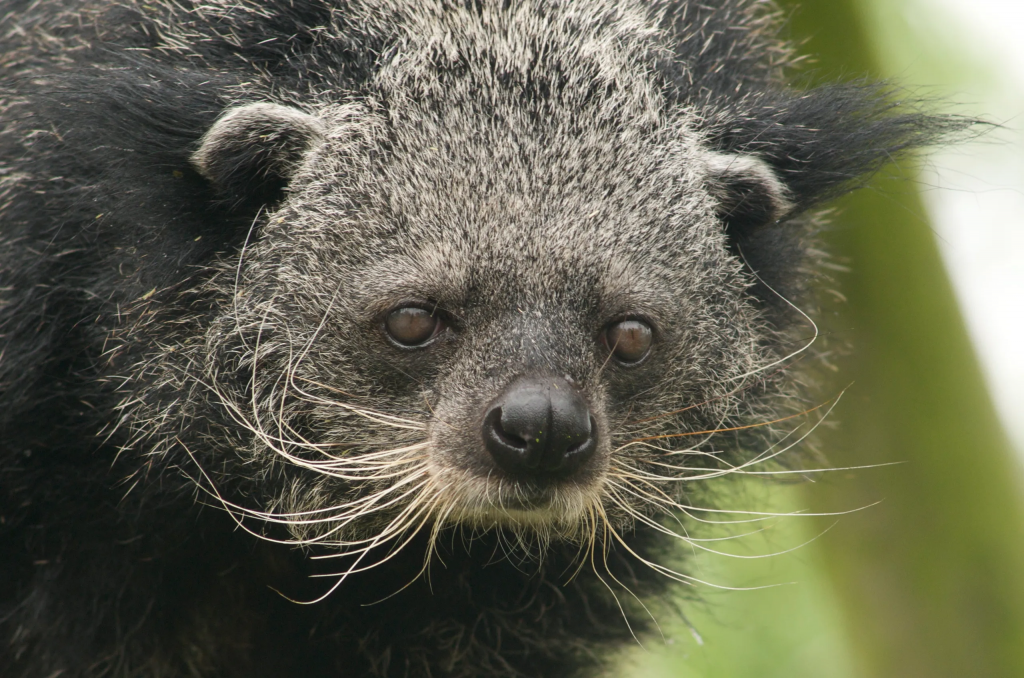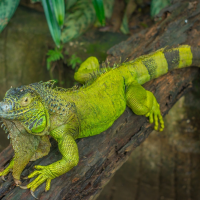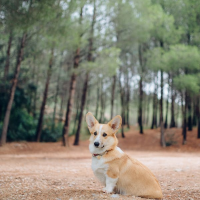The binturong (Arctictis binturong), often known as the bearcat, is a viverrid endemic to South and Southeast Asia. It is scarce over much of its range and is classified as Vulnerable on the IUCN Red List due to a diminishing population. It is expected to have decreased by at least 30% since the mid-1980s. The genus Arctictis has only one species, the binturong.

Table of Contents
Quick Facts
- Scientific Name: Arctictis binturong
- Lifespan: 10-15 years in the wild, up to 25 years in captivity
- Habitat: Dense forests of Southeast Asia
- Diet: Fruits, small mammals, birds, insects, and plant material
- Size: 24-38 inches in body length; 20-31 pounds in weight
- Activity Level: Moderate; primarily nocturnal
- Social Structure: Solitary or small family groups
History & Origin of Binturong
The Binturong sometimes known as the bearcat is a remarkable animal that lives in deep woods across Southeast Asia from India to the Philippines. Despite its name the Binturong is not a bear or a cat but rather a member of the Viverridae family which includes civets and genets. Binturongs have been around for millennia and play an important role in local folklore and traditional medicine. They have long been appreciated for their distinctive look and elusive character and certain cultures think they bring good luck.

Physical characteristics
Binturongs are easily identified by their shaggy black hair, tufted ears and long, bushy tails. They are medium to large sized animals weighing between 20 and 31 pounds and measuring 24 to 38 inches long. Their prehensile tails which may be as long as their bodies are a distinguishing trait that allows them to grip trees and explore the forest canopy effortlessly. Binturongs have powerful limbs and curved claws designed for climbing. Their features are rounded with tiny dark eyes and thick beards. One of the most remarkable parts of their appearance is the perfume they emit which is sometimes described to the aroma of buttered popcorn and is produced by scent glands placed near their tails.
Temperament and Personality
Binturongs are mostly solitary creatures, however they can occasionally be encountered in tiny family groupings. They spend the majority of their time foraging and wandering at night. Despite their solitary behavior Binturongs are noted for their sweet and inquisitive personalities. They may become fairly tame and even friendly in captivity with consistent interaction and handling. They are clever and curious frequently interacting with their surroundings via play and exploration. When threatened Binturongs may give a succession of growls, hisses and low roars to repel predators.

Exercise and Activity Needs
Binturongs are arboreal species that spend much of their time in trees. In the wild they navigate across the forest canopy utilizing their prehensile tails and muscular limbs to go from branch to branch. Captive Binturongs require a big well-equipped habitat that enables them climbing and exploration. Providing a variety of branches, ropes and platforms can assist to simulate their natural environment and stimulate physical activity. Although they are generally nocturnal they can also be active during the day particularly in captivity. Regular exercise is vital for avoiding obesity and improving general health and well-being.
Grooming & Care
When it comes to grooming binturongs require little effort. Their thick hair requires little maintenance although frequent parasite and skin checks are suggested. They are clean creatures who brush themselves frequently. A well-balanced diet rich in fruits, small animals, birds, insects and plant material is essential to their health. Fresh water should always be available. Puzzle feeders and foraging toys can help keep them cognitively busy while also allowing them to engage in natural activities. Providing hiding places and climbing structures in their cage is also critical to their psychological well-being.

Health and Common Concerns
Binturongs are typically resilient creatures however they might be prone to certain health difficulties especially in captivity. Obesity is a major worry owing to their low exercise levels and plenty of food. Dental health is also vital since they require a diet rich in hard foods to maintain their teeth clean and robust. Binturongs can also develop respiratory illnesses particularly if their housing conditions are not well ventilated. Regular veterinarian check-ups are required to maintain their health and handle any issues swiftly. Stress can be a serious problem for captive Binturongs frequently caused by insufficient space a bad food or a lack of environmental enrichment.
Training and socialization
Training a Binturong involves time and positive reward. They may be taught to listen to simple orders and tolerate handling if they are introduced at an early age. Treats and gentle encouragement can assist to increase trust and reinforce desired actions. Early socialization is essential to guarantee their comfort among humans and other animals. Gradual exposure to new locations, noises and experiences might help them lose their inherent skittishness and become more adaptive to shifting environments. Building a relationship with a Binturong entails respecting their space and allowing them to interact at their own speed.

Conclusion
The Binturong with its distinct look and interesting activities is a wonderful creature of Southeast Asian jungles. Their prehensile tails and arboreal existence make them one of nature’s most fascinating critters. While they can be difficult to care for in captivity because to their unique demands and nocturnal habits, understanding their physical, mental and social requirements is critical to guaranteeing their health. With the right care and attention, these fascinating animals may thrive and continue to amaze people who have the opportunity to see them up close.
People also search for: Red River Hogs: The Colorful Navigators of Africa’s Wild Terrains
















